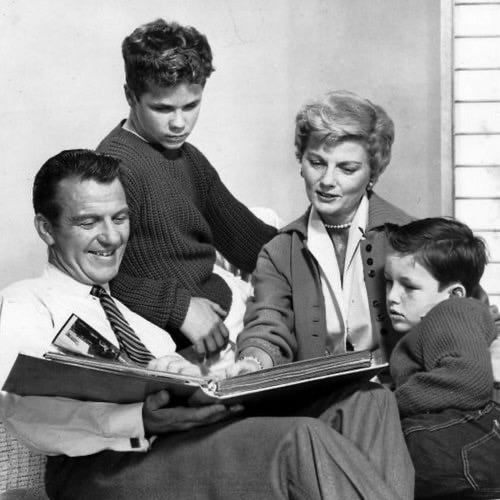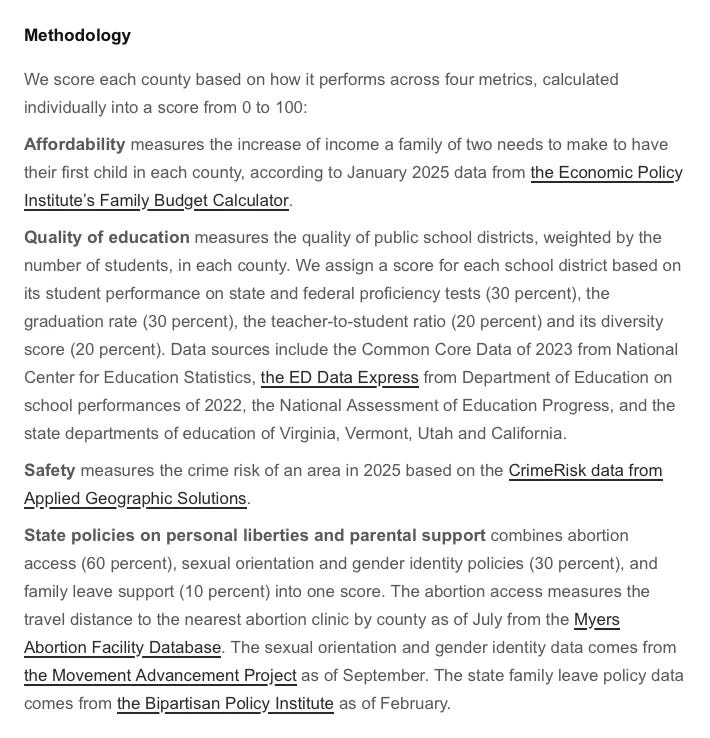How WaPo makes woke parents look good
They rigged the data for their guide on where to raise one's family
This week, The Washington Post published a seemingly innocuous article, “What’s the best place to raise a family? We scored every county.” There’s only one problem. They don’t actually attempt to answer that question. Instead, they rigged a scoring system to make conservative counties look like terrible places to raise kids, while rewarding counties with progressive policies—and then called it data journalism. The implicit message? Good parents are woke parents.
The article begins by observing that America faces a demographic collapse, even though many couples would like to have children:
The United States is reaching its lowest birth rate in history, but that alarming outcome isn’t necessarily intentional. Pew Research Center data show that the majority of young Americans today still want to have children: More than 7 out of 10 people in their 20s and 30s have or plan to have at least one child, and the majority of nonparents between ages 18 and 34 say they want to be parents someday.
The problem isn’t a lack of desire, but a lack of opportunity. Economic insecurity and the cost of raising children is consistently the strongest driver of the declining U.S. birthrate. Housing costs in desirable metro areas have outpaced wages for decades. One recent study found that rising housing costs since 1990 were responsible for about 51% of the fertility-rate drop between the 2000s and 2010s. Childcare costs have become the equivalent of a second rent or mortgage payment in many cities. In fact, the price of childcare for two children exceeds the average housing cost in three out of four U.S. regions, and across the 100 largest metro areas, the average monthly cost of full-time, pre-K childcare is 39.4% higher than the average monthly rent.
Additionally, American social patterns have shifted dramatically. People now marry much later—on average, at around 30 years of age—as more time is spent on careers and individual fulfillment. As I have argued before, we have slipped into a narcissistic society where our friendships have become funships, our careers are decided by what we’d most like to do, and our success in marriages is measured by how happy we are. The internet, social media, and artificial intelligence have exacerbated the problem, offering us shallow pleasure in exchange for deeper meaning, and many young people are unthinkingly making that trade.
The Death of Meaning
A culture drowning in algorithmic spectacle is killing our sense of meaning and replacing real experience with a funhouse mirror of our own collective unconscious.
But this is not the analysis that the Post provides. The author explains that in their search for the best place to raise one’s kids, they gathered data for every county in the United States across four metrics: affordability, education, safety, and liberty. On their face, these seem like sensible metrics. And it turns out, the highest-ranked places cluster in Maine, Massachusetts, Maryland, and New Jersey. But here’s the wrinkle:
Though Maine, Massachusetts, and Maryland might offer the best locations to raise a child, they are not among the top 10 states with the highest concentration of young parent households. There is almost no relationship between how high the states score on average and whether families with young children live there. The highest shares of households with children younger than 18 are in Utah, Texas, and Idaho.
The author then puzzles over why parents are not choosing the “right” places to raise their children, noting that “One reason behind this gap is that across the nation parents focus a good amount on affordability and education quality, but not as much on crime risks or state policies when it comes to where to raise children.”
It’s rather hard to believe that parents don’t much care about high crime rates when looking for a place to raise their kids. And it should be, because it’s untrue. Parents value safety extremely highly, but what the Post failed to consider is that not all parents can afford to live in the safest neighborhoods, which tend to be the costliest. But another factor is that poor parents tend to have more kids, and if poor people are having more kids then you’re going to find more households with children under 18 in poor areas. But it’s not very smart to therefore conclude that this is because those parents want to live in those areas.
That said, let’s take a closer look at our three outliers—Utah, Texas, and Idaho—and ask ourselves what, if anything, these states have in common. And the answer is that a simple glance at their demographic profiles reveals a set of shared characteristics that do offer some answers. The most striking commonality is that all three states have younger populations than the national average. In fact, they are among the youngest states of all, which means more adults in those states are in their prime child-bearing years, and that alone tilts the household structure toward families with children. But in addition to these factors, culture also plays a role. In Utah, the influence of the LDS Church (Mormons) plays an important and measurable role in shaping attitudes toward child-rearing. Idaho’s intermountain-west culture reflects rural, tight-knit, and often religious communities that historically favor family-centered life. Texas blends cultural conservatism with large Evangelical and Catholic populations, both of which correlate with higher fertility and an emphasis on family stability. Across all three states, socio-religious norms tend to reward child-rearing.
A final factor worth considering is that Texas and Idaho have become major destinations for young families leaving California and other high-cost states in search of affordability, schools, safety, and room to grow. These newcomers tend to be younger, poorer, and more likely to have children, reinforcing the demographics listed above that are already present. But the problem for the Post is that these three states are very conservative. Rather than consider the factors above, this leaves the Post wondering why families seem to prefer red counties:
Our analyses show that affordable places that offer better education have a positive correlation with where young parents live, but state policies for parental support and personal liberties have little to do with locations of families.
This strongly suggests young parents do not value “parental support” or “personal liberties” very highly, which is a staggering finding, if true. But glossing their methodology, we quickly see that this is not at all the case, and that they are heavily weighing these otherwise reasonable metrics as measurements of progressive politics.
Some of the problems you may notice include mismatched units of analysis, arbitrary weighting schemes, the blending of unrelated indicators, and the use of questionable proxies, all of which create a ranking that reflects editorial assumptions about one’s politics rather than a useful index based on empirical reality.
One of the most fundamental problems arises from the decision to score counties while using data derived from school districts, two administrative units that rarely align neatly given that many counties contain multiple districts with drastically different performance levels. The methodology also relies on a series of weighting decisions that appear to be normative rather than empirical. For instance, in the education category, student test performance and graduation rates each receive 30% weight, while teacher-to-student ratio and district diversity account for 20% each. No justification is offered for this configuration. A rigorous statistical approach would test whether these components actually measure the same underlying construct and would derive weights using techniques such as factor analysis or regression modeling. Instead, the weights reflect subjective judgments, such as pretending that diversity is almost as important as graduation rates, rather than demonstrated statistical relationships. And as someone who lived in East Asia for almost 20 years, working in both journalism and education, I can tell you that East Asians are the best-performing students on the planet, and their classrooms are among the least diverse of all.
Diversity is fine if you happen to like diversity, but it is false to claim that diversity is objectively a strength over unity, particularly when diversity is defined according to variety in race, religion, sexual orientation, or gender identity as opposed to viewpoint diversity, which is the only kind that objectively contributes to a better education. Put another way, to rate diversity as being almost as important to a child’s education as graduating is not a measure of “quality of education,” but of being woke.
Trans Women Are Trans Women
By now, you’ve probably noticed we live in an age where the trivial must be litigated and the obvious must be defended, lest the mob accuse you of heresy against whatever orthodoxy is trending this week. God help us that we need to write essays on clown-world topics like this. Or that we have arrived, absurdly but inevitably, at a moment in history when…
But it gets worse. Skip down to the section on liberty. All rational parents should seek to live in a place where they have liberty. You only have to imagine raising your children in a communist regime such as Venezuela or North Korea to immediately grasp why this is so, and how it ties deeply into the metric of safety. Think of Jeff Younger, who lost custody of his son because he did not enable the boy’s belief that he was a girl. That is the kind of liberty that every parent should fear losing. But that is decidedly not what the Post has in mind. Indeed, its metric is closer to the opposite of this, giving 60% weight to abortion access, 30% to support for gender ideology, and 10% to family leave. In other words, if a county gives generous maternal and paternal leave so that parents can stay home and spend those first precious months or years with their children, that’s all well and good, but it is three times more important for counties to support trans ideology, possibly by teaching impressionable young children that such delusions are actually healthy, possibly by removing children from their fathers because their father is, say, a Republican. Or a biologist. And is it truly six times more important for raising a family that one have access to abortion?
Now, one can choose to value these things. One may want to live in an area with abortion access, for example, because that puts more of the decision-making around reproduction in the hands of the mother, and some potential mothers who face fewer legal penalties may then be more likely to have kids. Or you may be the parent of a child who identifies as transgender. If the Post wants to give such people metrics to find places to live, that’s one thing. But to package those metrics as “good for the family,” then to puzzle over why so many families do not seem to value these things, is a particularly gross manipulation.
In the end, the Post isn’t telling parents where to raise their kids. It’s telling them what kind of parents they should be. No thanks. As a journalist myself, let me give you a tip, WaPo. Parents don’t need journalists to tell them what their values should be. They need data that respects the values they already have.






